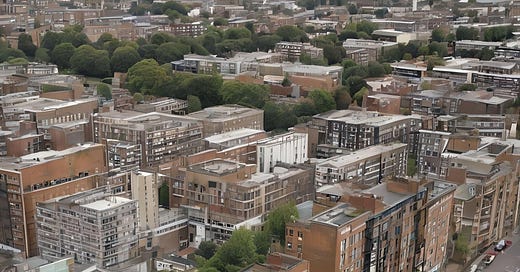Counter-urbanisation, the migration of people from major urban areas to smaller urban settlements and rural areas, is a process that has gained significant momentum in recent decades. This movement has profound social and economic implications for both the originating urban areas and the receiving rural locales. To understand the full extent of these changes, it is crucial to explore the drivers behind counter-urbanisation, the resultant demographic shifts, and the ensuing socio-economic transformations.
Drivers of Counter-Urbanisation
Several factors contribute to the rise of counter-urbanisation:
Negative Aspects of Urban Life: The built environment in cities often includes high-density housing, pollution, noise, and congestion. These negative aspects drive people to seek the tranquillity and space available in rural areas.
Increased Car Ownership and Affluence: Greater affluence and widespread car ownership enable people to commute from rural areas to urban jobs, making it feasible to live further from city centres.
Technological Advancements: Improvements in telecommunications and the rise of remote working have reduced the necessity for people to live near their workplaces.
Evidence of Counter-Urbanisation
Visible signs of counter-urbanisation include the development of modern housing estates and executive homes in rural areas, often on newly designated building land. Additionally, former farm buildings are frequently converted into exclusive residences, reflecting a growing demand for rural living spaces.

Social and Demographic Changes
The demographic changes resulting from counter-urbanisation are multifaceted:
Population Shifts: Rural areas experience an influx of young to middle-aged married couples or families with children, and an increase in older residents and second home owners. Conversely, young village-born adults often out-migrate seeking education and employment opportunities in urban areas.
Age Structure: The age structure of rural communities may shift, with a higher proportion of older residents. This can impact local services, such as schools and healthcare.
Social Integration: Newcomers may bring different cultural norms and lifestyles, leading to social tension and conflicts with long-standing residents.
Social Outcomes and Community Tensions
The social outcomes of counter-urbanisation are diverse:
Service Closures: The arrival of affluent newcomers, who continue to use urban services, may lead to the closure of local services like bus routes, schools, churches, and post offices. This can create friction between new and existing residents.
Cultural Diversity: Greater diversity can enrich local communities, but it may also challenge traditional social structures and lead to segregation.
Economic Inequality: Rising land values and house prices driven by demand from affluent newcomers can make housing unaffordable for locals, exacerbating economic inequalities.
Economic and Social Changes in Urban Areas
The urban areas losing residents to counter-urbanisation also undergo significant changes:
Population Decline: Loss of higher-income groups can lead to a decline in the urban environment, with housing falling into disrepair and a potential 'donut effect' where city centres deteriorate.
Economic Activities: Economic decline may follow population loss, resulting in the closure of schools, healthcare facilities, and businesses. However, positive impacts might include reduced housing pressure and congestion, and changes in the cultural or ethnic mix.

Impact on Rural Areas
The influx of more affluent newcomers to rural areas brings both opportunities and challenges:
Pressure on Land: Increased demand for housing can lead to the expansion of suburbanized villages, raising land values and house prices. This may result in further displacement of local residents.
Service Support: New residents, often with higher disposable incomes, can support local services and businesses, fostering economic growth.
Employment Patterns: Advances in technology, such as the internet, allow more freedom in employment locations, potentially supporting local services and reducing the need for commuting.
Overall Evaluation of Economic Change
The extent of economic change due to counter-urbanisation depends on several factors:
Local Services: The degree to which local services are supported by new residents plays a critical role. Professionals and retirees with higher disposable incomes can boost local economies.
Commuting: Increased commuting can lead to greater journey times and congestion, affecting economic productivity.
Business Opportunities: Edge-of-town shopping areas and business parks may benefit from new companies relocating, providing employment opportunities and stimulating local economies.
Counter-urbanisation leads to profound social and economic changes. While it offers opportunities for economic growth and diversity in rural areas, it also brings challenges such as social tensions, economic inequality, and environmental pressures. The overall impact of counter-urbanisation is shaped by the rate of expansion, the characteristics of newcomers, and the adaptive capacity of both rural and urban communities.
References:
Champion, A. G. (1989). Counterurbanization: The rural-urban migration reversal. Macmillan.
Lee, R. B. (1966). A typology of migration. In J. A. Jackson (Ed.), Geographical Review.
OECD (2015). Rural development: Bringing back the countryside. OECD Publishing.
Effects of counter-urbanization on Mediterranean rural landscapes | Landscape Ecology (springer.com)







